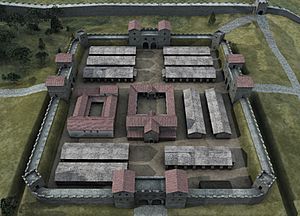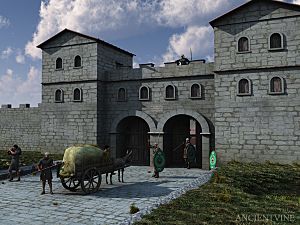Pons Aelius facts for kids
Pons Aelius was a Roman fort and a small settlement in ancient Britain. Its name means "Aelian Bridge" in Latin. It was located on the north side of the River Tyne, where the city of Newcastle upon Tyne is today. This fort was an important part of Hadrian's Wall, a famous Roman barrier. Roman soldiers lived here from the 100s AD to the 300s AD.
A Look into History
Pons Aelius was built at the eastern end of Hadrian's Wall. This was where The Castle, Newcastle stands now. The name "Aelian" comes from Emperor Hadrian, whose family name was Aelius. He visited Britain in 122 AD and saw the need for a wall to protect the Roman lands.
The settlement around the fort probably had about 2,000 people. The fort itself was quite small for a Roman fort, covering about 1.53 acres (6,200 square meters). A military road likely ran from the fort along Hadrian's Wall. This road connected all the forts and small watchtowers called milecastles along the wall.
The fort and its bridge were built at the end of a road called Cade's Road. This road might have stretched from Brough in Yorkshire to York and then to the fort of Concangis (Chester-le-Street). Pons Aelius was meant to be the end of Hadrian's Wall. However, the wall was soon extended further east to Segedunum (Wallsend). There is also evidence that the fort was rebuilt with stone. This probably happened when Emperor Septimius Severus was in charge (193 to 211 AD).
The fort is mentioned only once in an old Roman document called the Notitia Dignitatum. This document lists Roman military units in the 300s and 400s AD. The bridge at Pons Aelius is special because it's the only one outside of Rome named after an emperor. The fort was placed here to guard the river crossing. It gave the Roman Army a great view of the area. It was also a strong position at the northern end of the bridge.
Even with its bridge, Pons Aelius was not one of the most important Roman settlements in the north. Bigger and busier places were along Dere Street. This was a main Roman road that went from York through Hadrian's Wall. For example, Corstopitum (Corbridge) was a large supply center. It was much bigger and had more people than Pons Aelius.
The fort was left empty around 400 AD. Later, Anglo-Saxons built on the site. When archaeologists dug there from the 1970s to the 1990s, they found over 600 Anglo-Saxon graves.
Discovering the Fort
Most of the Roman fort is still buried today. It lies beneath the medieval Castle Keep, which gave Newcastle its name. Not many excavations have happened. There isn't much to see because the castle and city buildings are built on top of the fort. However, some parts of the fort are known to be near the castle. These include the commander's house (praetorium), the headquarters (principia), and two granaries (food stores). Their outlines are marked on the ground next to the castle keep.
The remains of an original milecastle were found behind the Newcastle Arts Centre. The exact path of Hadrian's Wall near the fort is still unknown. So, we don't know if the fort was directly connected to the wall.
Digs around the castle and in the River Tyne have found many Roman items. These include pieces of pottery, carvings, and seven altar stones. About eleven building inscriptions have also been found. One inscription mentions possible repairs to a bath-house outside the fort. More recently, a stone dedicated to Empress Julia Domna from 213 AD was found. All these items are kept at the Great North Museum: Hancock.
The altar stones and inscriptions tell us about the gods the Romans worshipped. These included Jupiter, mother goddesses (shown as three seated women), and Silvanus. Altars to water gods like Neptune and Oceanus have also been found. People probably worshipped them because the fort was so close to the river.
Some remains of the Roman bridge were thought to be found in 1872. This was during the building of the Swing Bridge over the Tyne. But today, experts believe the exact location of the Roman bridge is still unknown. No parts of it have been definitely found. The Roman bridge was estimated to be about 234 meters (768 feet) long.
Some recovered inscriptions might have decorated the bridge. Two large altars are thought to have stood on either side of the road on the bridge's central support. A large inscription might have been on a small archway, also on the central support. All traffic on the bridge would have passed under this arch. These two altars were pulled from the mud of the Tyne. They are in very good condition. This has led some experts to think they might have been dropped into the river on purpose. This could have been part of a special dedication ceremony for the bridge.
Two rare stone coffins were found where an old chapel used to be. They are thought to have held the bodies of rich and powerful people from the Pons Aelius fort. One coffin contained the body of a wealthy Roman, along with a silver hairpin.
Who Lived at the Fort?
A group from the Legio VI Victrix (The Sixth "Victorious" Legion) might have been here. They were probably in charge of building or rebuilding the fort in stone. We know this from altar stones found there. An inscription also mentions extra troops from Germany for Legio VI. These extra soldiers were needed after tribes in the north rebelled around 150 AD. They might have arrived with Governor Gnaeus Julius Verus around 158 AD.
A dedication stone to Emperor Hadrian's mother, Domitia Paulina, shows that the Cohors Ulpia Traiana Cugernorum civium Romanorum was stationed at Pons Aelius in the early 200s AD. This was a special unit of soldiers.
The Notitia Dignitatum document records that the Cohors I Cornoviorum (The First Cohort of Cornovii) was at the fort in the early 400s AD. These soldiers came from the Cornovii tribe in Cheshire and Shropshire. They were the only native British unit known to have been stationed on Hadrian's Wall.
A stone tablet found in Newcastle mentions the work of Cohors I Thracum on the vallum. The vallum was a ditch and earthwork south of Hadrian's Wall. However, it's not thought that this unit was permanently based at Pons Aelius.
See also
 In Spanish: Pons Aelius para niños
In Spanish: Pons Aelius para niños



